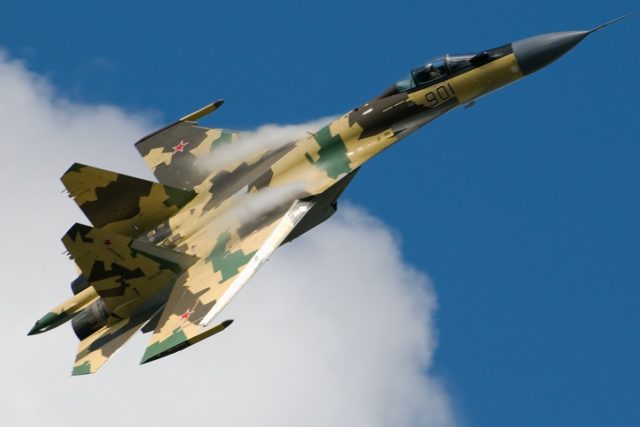
Russian fighter jets buzz 3 US aircraft ‘extremely close;’ one reportedly within 5 ft A SU-35 fighter jet in flight. (Aleksandr Markin, Wikimedia Commons/Released)
Russian military aircraft conducted dangerously close intercepts against U.S. Navy P-8A Poseidon reconnaissance planes flying in international airspace over the Mediterranean Sea on Friday and Saturday. One flight reportedly saw a Russian fighter jet pass within five feet of a U.S. aircraft, narrowly avoiding a collision.
CNN first reported on the Russian intercept flights on Wednesday, citing multiple U.S. officials familiar with the incident. Those U.S. officials described the Russian intercept as an “extremely close” encounter. Some officials told CNN there is video of the first incident, though the Biden administration has not publicly acknowledged any details about the incident.
A Pentagon spokesman confirmed in a statement to the Wall Street Journal that Russian Su-35 fighter jets had crossed into the flight paths of, not one, but three U.S. P-8As over the weekend. Unnamed U.S. officials told the Wall Street Journal that in one of the incidents, a Russian fighter jet flew within five feet of the U.S. aircraft.
The Pentagon is reportedly considering two of the interactions as unsafe and the third as unprofessional.
“We have made our concerns known to Russian officials through diplomatic channels,” Kafka told the Wall Street Journal. “While no one was hurt, interactions such as these could result in miscalculations and mistakes that lead to more dangerous outcomes.”
Flight tracking enthusiasts spotted at least four P-As flying over the Mediterranean Sea over the weekend.
Total of 4 USN P-8 Poseidon flights on Feb 11th and 12th, in eastern Mediterranean where these incidents most likely occurred. Flights in order. https://t.co/EIFQHr5K6e pic.twitter.com/eJ5FYzi8XP
— RivetJoint (@SpeckleBelly64) February 16, 2022
The series of at least three Russian intercepts of U.S. P-8As comes as more than 100,000 Russian troops have amassed around Ukraine for months. Last week, six Russian amphibious landing ships and an attack submarine entered the Black Sea through the Bosporus Strait, which connects to the Mediterranean Sea. The arrival of the group of Russian warships in the Black Sea, which touches Ukraine’s southern coast, raised the potential for a Russian invasion.
Each Russian landing ship can carry up to 10 main battle tanks and 340 troops, or 12 BTR amphibious armored vehicles, three main battle tanks and 340 troops. The six landing ships together could deploy more than 2,000 troops and 90 armored vehicles to attack Ukraine’s shores in conjunction with a Russian overland attack.
The KILO class submarine can also carry up to 24 naval mines, 18 torpedoes and four Kalibr land-attack missiles. The land-attack missiles could strike targets in Ukraine ahead of an invasion force and the submarine’s mines and torpedoes could further hinder either Ukrainian or NATO-allied ships from attempting to reinforce Ukraine by sea.
It’s not uncommon for Russian aircraft to intercept U.S. aircraft, and vice versa. While most intercepts between Russia and the U.S. are professional, Russia has conducted a few of what the U.S. has called unsafe and unprofessional intercepts of its aircraft.
In April 2020, a Russian fighter jet passed within 25 feet of a U.S. P-8A, while flying inverted. Days later, a second Russian fighter jet flew within 25 feet of a U.S. P-8A. In August of that year, another Russian fighter jet cut in front of a U.S. B-52 bomber as it flew over the Black Sea, flying within 100 feet of the bomber.
Such close passes risk a collision and, given the existing tensions, run the risk of setting off a wider military incident.




